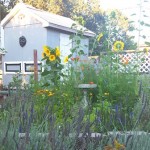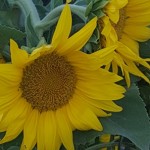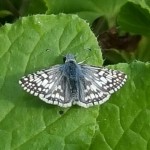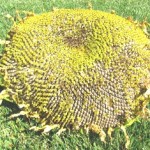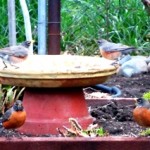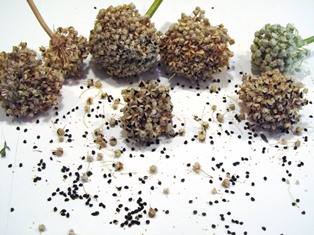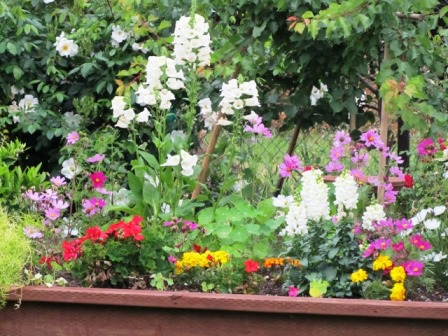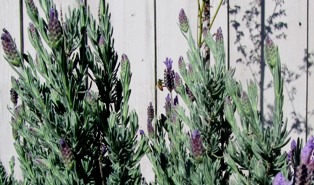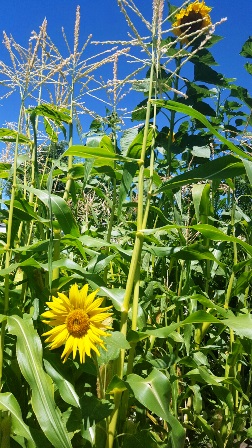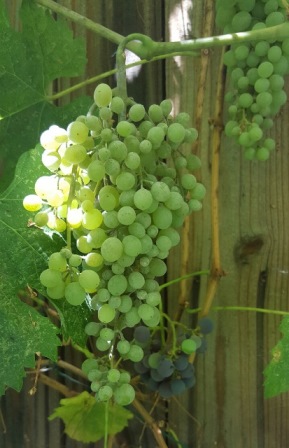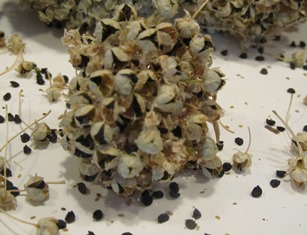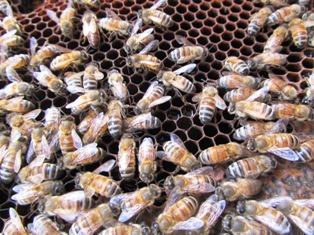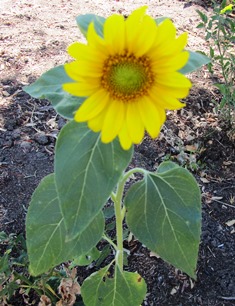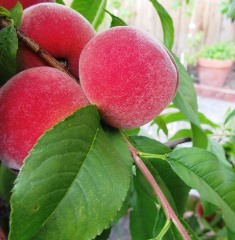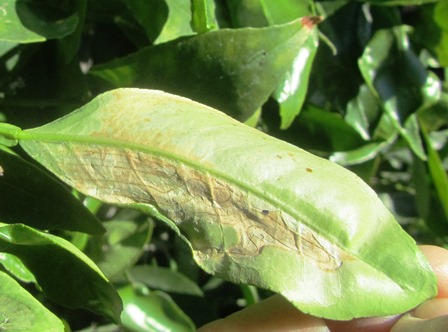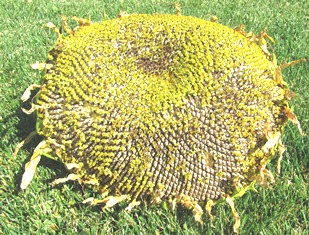Swarm in July–Does It Really Mean, “Ain’t Worth a Fly?”
Yesterday, after I’d fed and watered the chickens, I grabbed a two-gallon bucket and a ladder to pick some apricots for canning. But my morning didn’t go as planned when I spotted a cloud of bees swarming in the very fruit tree I was preparing to climb into. Nothing like a honeybee swarm to make you switch tasks in a hurry.
There’s a centuries-old saying among beekeepers: A swarm of bees in May is worth a load of hay . . . a swarm of bees in June is worth a silver spoon . . . a swarm of bees in July ain’t worth a fly. My beekeeper neighbor says simply, “A swarm in July . . . bye bye.” The rhyme echoed in my brain. Even early July? Should I try to save them? I donned my beekeeper suit and gathered together the items I would need for the rescue.
Ironically, in late winter I had hung a swarm catcher in the tree next to the swarm. A swarm catcher makes it easy to hive the bees since they are all inside the bucket-shaped unit with a small hole on one side and a large covered opening on the other. They go inside and you dump the bees into the hive box. I’ve had three swarms this year and not one of them went into the swarm catcher despite me putting attractant (a type of scented oil) in the vial inside the unit. Go figure!
Yesterday’s swarm wasn’t as big as the two I captured in May and June. I’m not even sure if I could save this one, but trying was better than losing them. I decided to help the small population along but putting into their hive some frames of comb and honey.
A swarm at this time of year (approaching the end of swarming season) will require extra food if the bees are to make it through autumn when they kick out the drones and then winter when their food and nectar sources become scarce.
I draw hope from the fact that August in the Bay Area brings blooms to certain species of eucalyptus and also star thistle. My bees also have access to lots of lavender. I have planted several types of it around my farmette.
The sunflowers in my garden are blooming now and will (thanks to consecutive planting) over the next several weeks. And I’ve got two raised beds designated as bee gardens full of blooming flowers and herbs like borage that attract bees, butterflies, and other pollinators.
It remains to be seen if this July swarm will have any worth at all. I think they’re going to need a lot of help. That means keeping my eyes on them as I take care of my chickens and keep the summer canning going.
_____________________________________________________________________________
If you enjoy reading about the workings of an urban farmette and also appreciate a good, clean mystery, check out my Henny Penny Farmette series of cozy mysteries–A BEELINE TO MURDER, THE MURDER OF A QUEEN BEE, and A HIVE OF HOMICIDES. I also write wellness and spirituality books–SACRED TRAVELS (soon to be updated to include color images), RITUALS FOR LIFE, and MY POCKET MEDITATIONS.
All my books are available at Barnes & Noble, Amazon, and other traditional and online bookstores everywhere.

More than 150 rituals for sound mind, strong body, and meaningful connections to the people around you
Plant for the Pollinators
I seldom need an occasion to put in another bed of flowers, but this is National Pollinator Week. I think a new bed is in order to attract local bees, birds, bats, and butterflies–all considered pollinators. Having these small creatures around benefits landscapes, gardens, and orchards.
The U.S. Fish and Wildlife Service has noted that over 75 percent of our plants are pollinated by birds, animals, and insects. We can help ensure these creatures will be around for a long time if we restore their habitats and ensure they have food and water.
There are many lovely plants you can grow that don’t require a lot of care.
- lavender
- bee balm
- echinacea
- sage
- cilantro
- thyme
- sunflowers
- sweet alyssum
- anemone
- borage
- geraniums
- scented pelargoniums
- mint
A tapestry of colorful herbs and flowers beautifies your landscape and pollinators love the diversity. If you don’t have a lot of space, grow some of these plants in planter boxes, clay pots, or other types of containers.
Put in a water feature, too, such as a table-top or larger fountain that recycles water. Even a pottery saucer filled each day can attract pollinators.
It won’t take long for the bees and hummingbirds to find the water. Their frequent visits are fun to watch, and they’ll likely be sipping throughout the day.
_________________________________________________________________________
If you enjoy reading about farmette topics, check out my Henny Penny Farmette series of cozy mysteries from Kensington Publishing. My newest novel includes delicious recipes, tips on keeping bees and chickens, and much more. Click on this URL for more information, http://tinyurl.com/ya5vhhpm
.
Gather Dry Seedpods Now for Next Year’s Garden
When I notice the seedpods of my favorite flowers beginning to dry, I start carrying a felt-tip pen and paper bags around the garden for collection and labeling. Also when my favorite varieties of heirloom pumpkins and squash are ripe, I’ll cut open the plants, collect the seeds, clean and dry them, and store in paper envelopes or glass jars.
Throughout the summer, I do the same with the best specimens of my heritage tomatoes and beans.
Gather the seeds of your favorite plants when the flowering (or production) is over and the pods are drying. On my patio harvest table, a long metal table with a tiled top, I place giant sunflower heads to finish drying. I then save some seed for replanting, the rest for eating. But I always share some with the squirrels and birds.
There are multiple bowls, buckets, and glass jars on the table, too. These hold the papery pods of lobelia’s tiny seeds and the onion seed heads that only need a good shaking onto a paper towel to remove the tiny black seeds. I’ve got containers of cosmos and also zinnia seeds, too, collected during early morning walks around my farmette.
When you plant open-pollinated heritage plants, it’s easy to keep a steady supply of seeds for next year’s garden. You can get an early jump on spring by sowing these seeds into seed flats or wait until the danger of frost has passed to sow them directly into prepared beds. The process of collecting, saving, and replanting seeds is how our ancestors did it, and it still works.
* * *
If you enjoy reading about farmette topics (including gardening, beekeeping, and delicious recipes), check out my cozy mysteries A BEELINE TO MURDER and also THE MURDER OF A QUEEN BEE in the Henny Penny Farmette series (from Kensington Publishing). These novels are chocked full of recipes, farming tips, and sayings as well as a charming cozy mystery.
The books are available through online retailers such as Amazon, Barnes & Noble, Kobo Books, and Walmart as well as from traditional bookstores everywhere.
See, http://tinyurl.com/hxy3s8q
This debut novel launched the Henny Penny Farmette series of mysteries and sold out its first press run. It’s now available in mass market paperback and other formats.
See, http://tinyurl.com/h4kou4g
Release date is September 27 for this, the second cozy mystery in the Henny Penny Farmette series. It’s available free on Net Galley (netgalley.com) for readers, bloggers, and other professionals who write reviews.
How to Attract Local Pollinators
Today, I spotted a gorgeous bee, big and black with reddish-brown wings, dipping its proboscis into the lavender wisteria and other blooms in my garden. I was stung by a bee yesterday, but that doesn’t stop me from smiling with delight observing this little pollinator at work in my garden.
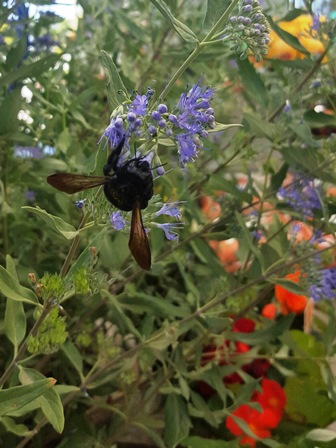
This longhorn bee, twice the size of a honeybee, dips its proboscis (meaning, tongue, nozzle, or snoot) into a bloom.
I admit I’m a fan of pollinators and enjoy watching them work amid the sunflowers, zinnias, cosmos, wisteria, and other blooms in the bee and butterfly garden I planted earlier this year.
The flowers attract hummingbirds, butterflies, bumblebees, and other types of bees, including my own Italian honeybees, the stock of bees most favored in this country (Apis mellifera ligustica). See, http://beesource.com/resources/usda/the-different-types-of-honey-bees/
Honeybees pollinate 90 percent of North America’s commercially produced crops, including almonds. That’s why many Northern California almond growers rent honeybees for use in their orchards during springtime bloom.
The National Academy of Sciences has noted that pollinators are needed to reproduce 75 percent of the Earth’s flowering plants. But there’s been a drop in natural pollinators, in part due to habitat loss and pesticide use.
Populations of the yellow, black, and brown Western bumblebee, once common from southern British Columbia to central California, have now all but disappeared. To attract bumblebees, plant giant hyssop, milk weed, and nettle-leaf horse mint. See, http://www.wildflower.org/collections/collection.php?collection=xerces_bumble
Here’s what else we gardeners and farmers can do to attract local pollinators.
1. Avoid using pesticides.
2. Plant bee, bird, and butterfly friendly native plants.
3. Choose plants that flower in varying diverse colors and shapes to attract a wide variety of pollinators.
* * *
If you enjoy reading about farmette topics (including gardening, beekeeping, and delicious recipes), check out my cozy mysteries A BEELINE TO MURDER and also THE MURDER OF A QUEEN BEE in the Henny Penny Farmette series (from Kensington Publishing).
These novels are available through online retailers such as Amazon, Barnes & Noble, Kobo Books, and Walmart as well as from traditional bookstores everywhere.
See, http://tinyurl.com/hxy3s8q
Now available in mass market paperback, this debut novel launched the Henny Penny Farmette series of mysteries and sold out its first press run.
See, http://tinyurl.com/h4kou4g
The second cozy mystery in the Henny Penny Farmette series, available Sept. 27, 2016
What’s Growing in the July Garden?
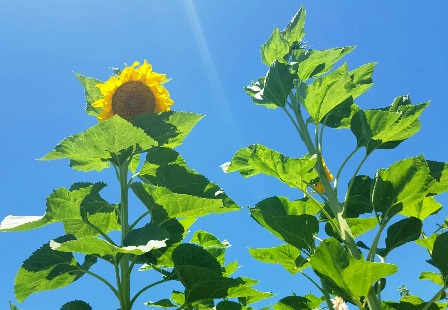
Sunflowers are native to North America and were taken to Europe in the 16th century; however, they date back to roughly 3,000 B.C. Honeybees love sunflowers.
Towering above the squash and lavender in my garden are rows of green corn stalks bearing ears of sweet, plump kernels. Snaking along the rows at the base of the cornstalks are vines laden with butternut squash and Armenian cucumber.
There are ripe tomatoes, too, especially the prolific heirloom–Red Beefsteak. I love cutting up some of these fresh, thin-skin tomatoes and combining them with basil, olive oil, grated cheese, and pine nuts as a topping for pasta. Add some grilled, seasoned chicken and you’ve got a quick and delicious summer lunch.
Zucchini and yellow squash sport large, showy blooms and are producing like crazy this month. While you can harvest and eat the blooms, we prefer the squash. Zucchini is delicious grilled or tossed with rosemary potatoes and onions or made into a French lentil and tomato salad (see recipe from last week’s posting).
Growing on vines trained over a wall and on supports, the green table grapes are beginning to swell. The taste is still a little tart, but will sweeten with the passage of another couple of weeks.
* * *
If you enjoy reading about farmette topics (including gardening, beekeeping, and delicious recipes), check out my cozy mysteries A BEELINE TO MURDER and also THE MURDER OF A QUEEN BEE in the Henny Penny Farmette series (from Kensington Publishing).
These novels are available through online retailers such as Amazon, Barnes & Noble, Kobo Books, and Walmart as well as from traditional bookstores everywhere.
Now available in mass market paperback, this debut novel launched the Henny Penny Farmette series of mysteries and sold out its first press run.
COMING SOON: The second cozy mystery in the Henny Penny Farmette series, available Sept. 29, 2016
Collecting and Storing Sunflower Seeds for Next Year’s Garden
Drying heads of sunflowers and storing the seeds is easy. If your sunflowers have dry heads, ranging in size from saucers to large dinner plates, and they have turned brown and most of the petals have fallen off, the seeds are ready for harvesting.
Simply place a paper bag over the drying head and band it or tie with string to keep the birds and squirrels from foraging. Trust me, they’ll eat all your seeds if you permit it. The bag keeps the seed from dropping onto the ground to be foraged by wildlife or to generate new plants.
I like to the cut off the head, leaving eight or so inches of stem on it. This way, there is stem to tie and hang so that the head is positioned upside down in a bag. This position can facilitate the drying and captures all the seed while hanging in a drying shed. Retain this bag of seeds for replanting. The seeds are how the sunflower reproduces itself. Sunflower heads can hold thousands of seeds, depending on the size.
A word of caution here: don’t harvest the seeds and leave them drying in a tray in your shed the way I did. That will attract rodents. A coffee can with a plastic lid works great for storing sunflower seeds.
The best seeds for snacking are the gray and white striped sunflowers. There are other types of seed–for example, a black one and grayish-white seed, but the striped seeds are delicious. After you chew open the hull and spit it out, there’s a lovely seed inside it that tastes great and is nutritious.
Gathering Seed for Next Year’s Garden
The sounds of summer around our farmette have grown quieter. It’s mid-August and the neighborhood children have returned to school. I miss their laughter. I miss the delight on their faces at seeing the chickens and the honeybees. I miss keeping them company at their lemonade stand.
But I admit to the secret pleasure of solitude and quiet, though it isn’t really silence. It’s the peaceful clucking of chickens and the twitter of songbirds as I gather seed from plants that have bloomed and dried, such as the cosmos, nasturtiums, sunflowers, and wisteria.
The wisteria vine that exploded in growth of long, green tendrils during spring and early summer and graced us with bracts of purple perfusion now hold heavy pods. The pods contain seeds that can be dried and planted for new vines next year.
The sword-shaped leaves of the irises are dry–their blooms a memory from early spring. I’ve already cut their long leaves back into four-inch fans and will dig some of the rhizomes for replanting in other beds around the farmette.
The sunflowers that the bees love to forage on have gone to seed. Those seeds will become next year’s plants, but some we’ll save for the squirrels.
The red and yellow onions have developed seed pods on long shoots now. I’ll plant those in raised beds in the fall for a spring crop of onions.
Yes, the dog days of summer have come around again. But the growing season continues. End of summer gives rise to autumn when grapes, persimmons, pumpkins, figs, and pomegranates ripen. On the farmette, there is always another season and other crops to look forward to with anticipation. It’s the good life.
An Heirloom Selection of Old Varieties of Flowers
Mid-March to early April on the farmette brings the celebration of birthdays and the promise of new selections of flowers for our spring gardens. This year, our new plants are old varieties.
A fellow-gardener friend gave me a selection of antique flowers for pollinators that included Bee Balm, Sweet Alyssum, Prickly Poppy, Sunflowers, and Kiss-Me-Over-The-Garden-Gate. These will go in various flower beds around our property.
Pollinators include many species of bees. We want them in our gardens to pollinate our fruits, vegetables, berries, and nut crops. Planting open-pollinated flowers enable pollinators to forage for pollen and nectar (their sources of food). When we provide rich food sources for pollinators, our food crops will benefit.
At a time when bee populations are declining worldwide, gardeners everywhere can help the besieged bees by planting diverse, open-pollinated varieties of pollen- and nectar-rich flowers. The following flower selection are considered old garden mainstays.
Bee Balm–“Bergamo” Monarda hybrida
This perennial likes sun to light shade and soil that is moist, and well-drained. The plant will reach two feet tall and will bloom summer to fall. It attracts both hummingbirds and bees.
Sweet Alyssum–“Benthalmii” Lobularia maritima
Alyssum is an annual that likes full sun but part shade in the hottest areas of hte garden. Soil preferences is rich, moist, and well-drained. It reaches a height of ten inches and small white blooms form summer to fall. It will flower repeatedly if it is clipped back after flowering.
Prickly Poppy–“Busy Bee” Argemone platyceras
A sun lover like all poppies, this one is an annual that loves poor, dry, gravelly soil. It will grow to three feet and bloom throughout the summer into fall. It does have prickly spines, so care must be taken to avoid contact with the spines.
Sunflowers–“Pan,” Helianthus debilis, subspecies: cucumerifolius
Another sun lover, this annual thrives in rich, well-drained soil. Plants will reach three feet in height and bloom summer through the fall. These sunflowers make excellent cut flowers.
Kiss-Me-Over-The-Garden-Gate–” Polylgonum orientale
This annual will go at the back of the garden since it reaches a height of six to seven feet. It likes well-drained, moist, rich soil that is located in full sun. The plants bloom summer throughout the fall and self-sows.
Spate of Warm Weather Brings Out Early Blosssoms
While schools across the nation are taking snow days because of frigid temperatures, the fruit trees on my Bay Area farmette are showing signs of bud swelling and early blossoming because of a winter heat wave.
Cities around the San Francisco Bay are experiencing early January temperatures of 70-plus degrees Fahrenheit, breaking weather records in some areas. Mother Nature certainly behaves strangely at times.
My five-variety apple tree and the early Desert Gold peach trees are covered with buds that are already showing color. I haven’t as yet gotten around to the winter pruning and spraying with organic oil. Maybe if there’s no wind today, I’ll squeeze that chore in with the others.
I did cut back the Washington navel orange that is infected with Leaf Miner, a pest that’s crossed the United States from Florida. It attacks new leaves, so I’m thinking if I prune and spray now before spring is in full swing, maybe I won’t lose this tree. Curiously, the pest hasn’t widely infected my blood orange trees but there are signs of it in the leaves of our Satsuma seedless tangerines.
Elsewhere, I’ve done deep digging in the chicken run and added some wood chips and leaf material for compost.
The tea roses have been pruned back to 12 to 18 inches and old canes removed. I’m torn between wanting to add more roses in the beds in front of the bamboo plants on the east/west axis of our property or adding more lavender and sunflowers, favored by the bees.
Tomorrow, I’ll open and inspect my bee hives. I left honey stores this past autumn instead of harvesting. But if the bees have gone through all the honey, then I’ll have to add bee food until we get the first early bulb blooms and wildflowers. The French perfume lavender that the bees love is about the only bloom (bee food) in the garden now. Luckily, I planted a lot of it.
The farm chores don’t just seem endless, they are. But whether the work is daily, weekly, or seasonal, there’s something deeply rewarding–even magical–about living close to the earth in harmony with cycles of seasons and the rhythms of nature. But I admit, it is a little strange to have such warm weather when winter has only just started.
Sunflowers-A Source of Beauty and Food
Sunflowers have inspired human expression for centuries. The Incas made the sunflower a symbol of their god. In Europe, sunflowers symbolized kingship and were cultivated in gardens, at least until the 18th Century when they fell out of favor. The artist Vincent Van Gogh immortalized these sun-facing flowers in his paintings that bear witness to the hot summers he spent in Arles.
In fact, nothing symbolizes summer like the sunny faces of sunflowers. That image of beauty is a widely used motif in garden art and home goods. Freshly cut sunflowers in a jar, vase, or tin can brighten any room in which they are placed.
Native Americans ate the seeds or ground them for use in breads and cakes and used the dyes for body paint and clothing. Today the seeds are dried and roasted or sold as natural. The oil is pressed and used in cooking. Sunflower seeds are high in protein and are considered a healthy snack.
Even children can plant and tend sunflowers; they are easy to grow. The giant cultivars require ample garden space but planted in a circle or square, they can become a living fort that children enjoy playing under. Sunflowers are heavy feeders, so amending the soil with compost and manure will benefit their growth cycle. The plants are not particular about soil type but they do need regular watering.
Sunflowers can bear a single head, containing petals and seeds, or several heads on a single stalk. They range in size from small to giant stalks of twenty feet or more. Giant heads grow as much as two feet across.
Depending on the cultivar, the centers of these lovely flowers range from dark brown or black, or gray and white striped. The seeds are a favorite food of squirrels and birds and honeybees. Here on our farmette, we grow sunflowers near the apiary along with lavender. High-value food sources keep the bees around to pollinate the rest of our garden. And I can’t resist putting a few small heads in a jar to brighten my kitchen window.
 Facebook
Facebook Goodreads
Goodreads LinkedIn
LinkedIn Meera Lester
Meera Lester Twitter
Twitter






